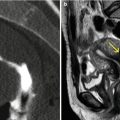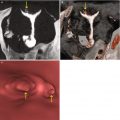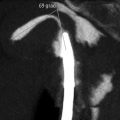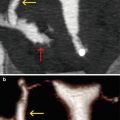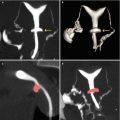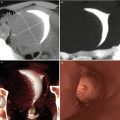, Carlos Capuñay1, Carlos E. Sueldo2 and Juan Mariano Baronio3
(1)
Diagnóstico Maipú, Buenos Aires, Argentina
(2)
University of California, San Francisco, CA, USA
(3)
CEGYR, Buenos Aires, Argentina
In the daily practice of the imaging department, the virtual hysterosalpingography (VHSG) examination is performed with iodinated contrast; however, in patients with an allergic history, and in particular with radiographic dyes containing iodine, its usage is contraindicated [1–5].
There exist different iodinated contrast mediums which have been utilized throughout the years for the X-ray hysterosalpingographies. These contrast agents are classified in two categories, depending on if they are lipid-soluble or water-soluble. Within the lipid-soluble iodinated contrast agents, the iodized oil (Lipiodol; Guerbet, Roissy, France) is a mixture of ethyl esters of iodized fatty acids of poppy seed oil. Due to its possible effect on the production of pulmonary fat embolism, persistence of the contrast in the peritoneal cavity as a result of the lack of absorption and the necessity of doing a pelvic X-ray 24 h after its administration, the general utilization of this contrast medium was desisted in all X-ray hysterosalpingographies.
Within the group of water-soluble contrasts there are two according to their physical and chemical characteristics; ionic and non-ionic. The ionic iodinated contrast materials are hyperosmolal with respect to the plasma, up to five times superior. These contrasts were the ones initially utilized to perform the VHSG studies.
The non-ionic iodinated contrast agents, with the advantage of having less osmolality, present a diminished rate of moderate and severe adverse reactions, although no scientific evidence that they reduce deadly reactions exists. These are the contrasts currently utilized to perform routine VHSG.
The exact mechanism responsible for the secondary adverse reactions of the use of iodinated contrast media is unknown. The most clearly identified factor up to date is the osmolality. It is ideal that this be the lowest possible or similar with regards to the plasma.
At the time of deciding which contrast to utilize, the objective is to try to fully reduce the possibility of the patient presenting an adverse reaction. These can have different causes and severities. When deciding and choosing the contrast media it is of utmost importance to take into account and control, the risk of allergic reactions
Regarding the cause, the adverse reactions can be classified into two basic types:
Toxic reactions: Are produced by the action of the chemical structure of the compound on the blood vessel cells, circulating proteins and enzymatic systems, leading to hemodynamic changes in said organs and structures. Albeit they can occur in everyone, they result more frequent when associated diseases which predispose to renal or cardiac damage exist. Such reactions are related with the quantity of injected contrast and tend to be reversible, except for severe damage on the pre-existing disease. Dehydration is added as a clinical condition that predisposes renal damage. Therefore it is always recommended that the patients be well hydrated, as a simple measure to avoid renal or clinical damage.
Pseudoallergic (anaphylactoid) reactions: They are reactions which occur in some persons by direct action of the contrast materials on the cells of the organism that stores chemical mediators that, when released, can lead to allergic reactions like urticaria, edema, asthma, rhinitis and shock. In the true or anaphylactic allergic reactions, the antibody responsible of the liberation of the substances is the immunoglobulin E (IgE). Currently, a reaction to the contrast material in VHSG studies is unusual due to the fact that non-ionic iodinated contrast of low osmolality is utilized. Nevertheless there is the possibility of a systemic reaction such as venous or lymph intravasation, event which can be found in VHSG studies. The VHSG studies are performed with iodinated contrast diluted to the 70 % which means that most of the volume instilled endocavitary constitutes physiological solution and only scarce milliliters of hipoosmolal contrast (approximately 4 mL).
The contrast intravasation in VHSG produces a reticular pattern with multiple hyperdense lineal images which represents the opacification of the uterine wall vessels. The increases in the intrauterine pressure and uterine surgeries are predisposing factors, but can occur in patients with no history of uterine abnormalities.
As far as severity, the adverse reactions can be divided in mild, moderate and serious:
Mild adverse reactions: Are the most frequent, occupying 99 % of all adverse reactions. They include symptoms such as nausea, generalized warmth, and facial blushing. They need no treatment and cease after a few minutes.
Moderate adverse reactions: Constitute 1 % of all adverse reactions. They exhibit themselves as diffuse hives, edema, mild bronchospasm and vomits. They require almost immediate treatment.
Serious adverse reactions: They are generalized hives, larynx edema, hypotension, bronchospasm or shock. They can appear in approximately 0.1 % of the total of reactions and require hospitalization. Eventually they can lead to death from cardiac failure, or irreversible neurologic damage from hypotension and hypoxia. These types of reactions are rare in patients undergoing this type of study. They are connected with more frequency to applications of intravenous contrast, than to endocavitary usage.
Hence in the case of patients with a history of iodine allergy, iodinated contrast media can be replaced with gadolinium.
The Research Team at Diagnóstico Maipú carried out a scientific investigation with the aim of testing gadolinium for the realization of these diagnostic studies.
Gadolinium, which is a paramagnetic substance utilized in magnetic resonance, has been used as a contrast medium in X-ray hysterosalpingographies to avoid possible complications caused by the iodinated contrast.
It must be taken into account that gadolinium is a safer contrast medium than iodine. An anaphylactic rate of 0.0003 % has been described in literature and a rate of adverse effects of 0.01 %, in intravenous injections. Hence the possible effect of endocavitary application is even lower.
Generally, the adverse reactions are mild, including nauseas, vomits, headaches and dizziness. The pruritus, maculopapular rash and other skin eruption of varying types are the most frequent and are rarely there is bronchospasm. Anaphylactic reactions are very infrequent (0.001–0.01 %).
Our research group evaluated the utility of gadolinium as a contrast agent to perform VHSG exams, and studied the intraluminal enhancement, the image quality and the discomfort of the patients compared to VHSG carried out with iodinated contrast, with the aim of determining if the gadolinium could be utilized as an alternative contrast in allergic patients. Fifty patients with a diagnosis of infertility were studied via VHSG performed in a 64-slice CT scanner (Brilliance 64; Philips Medical Systems, Cleveland, OH, USA). In 25 patients, the VHSG was performed with iodinated contrast and in the other 25 with gadolinium. The technical parameters used were the same for both acquisitions: 0.9 mm slice thickness; 0.45 mm reconstruction interval, pitch 0.64; gantry rotation time of 0.5 s; 120 kV and 100–150 mAs, with an average duration for each scan of 4 s.
The studies performed with iodinated contrast were done with a 15 % dilution in saline solution, and 40 % in the ones carried out with gadolinium. Twenty milliliters of dilution were used in each study. The endoluminal enhancement was evaluated in both studies hence a region of interest (ROI) was placed in the cervical canal and in the uterine cavity (Fig. 13.1). A quantitative analysis of the image quality was performed by an experimented radiologist with a scale of 0–10.
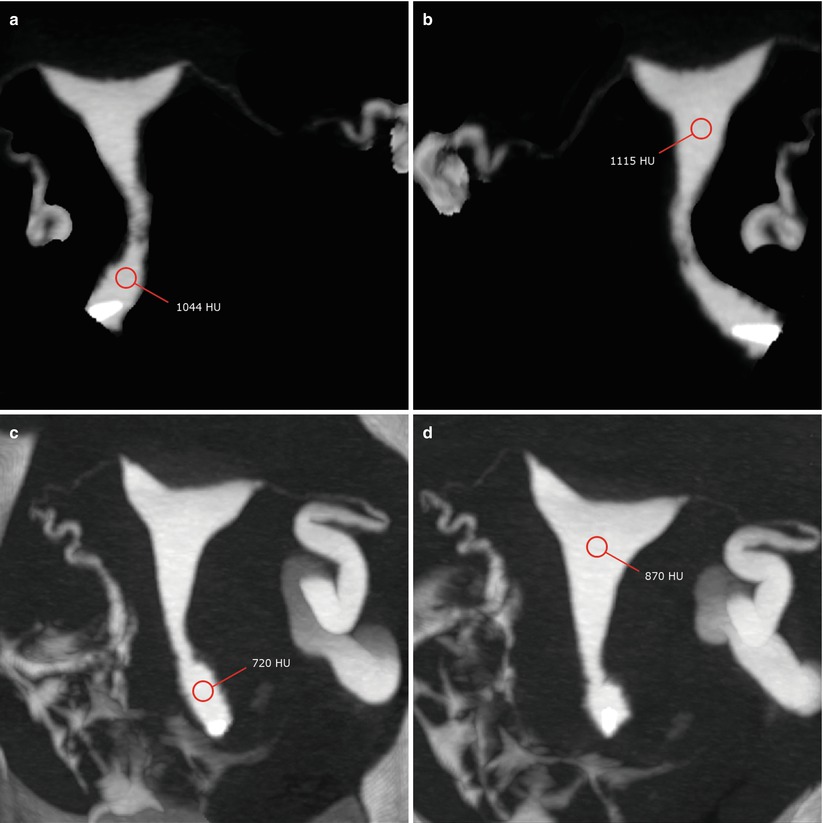

Fig. 13.1
CT density analysis in VHSG studies performed with iodine and gadolinium. (a, b) Measurements of the regions of interest (ROI) in the cervix and uterus in study with iodine. (c, d) ROI measurements in the cervix and uterus in study with gadolinium
Complementarily, each patient participated in a query informing the discomfort produced in the study. It was classified in five levels:
Level 0: no discomfort
Level 1: slight discomfort
Level 2: moderate discomfort
Level 3: severe discomfort
Level 4: intolerable
Description of the VHSG Procedure
The previous preparation of the patient was similar to the X-ray hysterosalpingography study. Nevertheless, due to the non invasiveness of the procedure, the prophylactic use of antibiotics was not required. The contraindications for the realization of the study were pregnancy and active pelvic infection. All the VHSG were performed between the 7th and 10th day of the menstrual cycle. All of the patients had to abstain from having sexual relations from the first day of the menstrual bleeding until 48 h after the realization of the exam.
Stay updated, free articles. Join our Telegram channel

Full access? Get Clinical Tree


